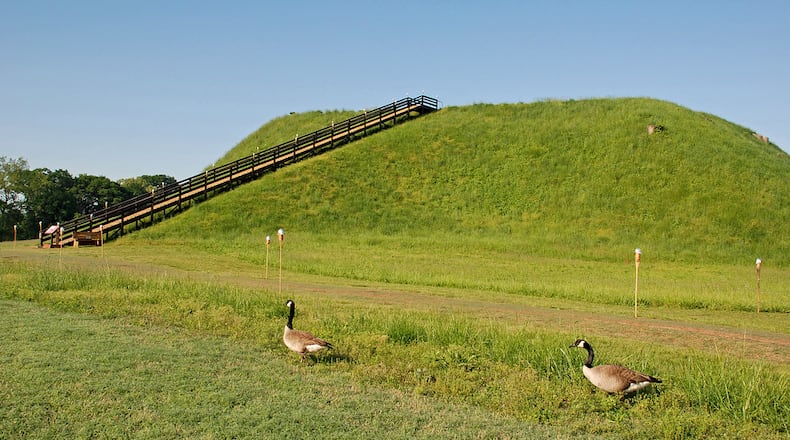In late January, the Department of Natural Resources (DNR) was scheduled to begin removing items of cultural importance and all funerary items of Mississippian period native people from exhibit at Etowah Indian Mounds State Historic Site in Cartersville.
In 2021, the Muscogee (Creek) Nation, one of the five tribes culturally affiliated with Etowah, filed an official repatriation claim for more than 187,000 funerary objects and 404 human remains of ancestors under DNR control.
This was done in accordance with the Native American Graves Protection and Repatriation Act (NAGPRA), enacted in 1990 to establish a process for the transfer of human remains and cultural, funeral and sacred objects from federal or tribal lands to lineal descendants and tribes.
The DNR had completed inventory of the items at Etowah in 1996.
So why is it taking almost 30 years for these items to be returned to cultural descendants?
“We have so many hoops to jump over to claim that these are our ancestors. It is just the way the law is written,” said Emman Spain, NAGPRA coordinator for the Muscogee (Creek) Nation.
While tens of thousands of ancestral artifacts and remains have been returned to tribes under NAGPRA, the regulations are long overdue for an update.
In October, after more than a decade of requests, the U.S. Department of the Interior announced proposed amendments to NAGPRA that would strengthen the authority of tribes in the process, shorten the time it takes to return items and push institutions to be more transparent about artifacts in their possession.
Less than half (41%) of the more than 1,700 Native American remains taken from Georgia have been made available for return to tribes under NAGPRA, according to ProPublica’s Repatriation database.
Of the 37 institutions that reported Native American remains taken from Georgia, the DNR holds 406 remains, the largest number of remains made available for return. The second largest number of remains made available for return (105) are held by the Robert S. Peabody Institute of Archaeology at Phillips Academy Andover in Massachusetts.
Some entities have tried to dodge regulations by claiming they do not receive federal funding, Spain said. And it is important to note that not all items are made available for return. Any artifacts that cannot be culturally affiliated with a tribe remain with the institution that holds them.
Archeologists for the Smithsonian were digging up artifacts at Etowah as early as 1884, a half-century after hundreds of Muscogee were forced out of the Southeast by the federal government.
In 1927, Warren K. Moorehead offered to ship graves and the contents from Etowah to any museum director or curator who made a request. Moorehead was a personal friend of the same Robert S. Peabody mentioned above who gave Etowah artifacts to Philips Academy.
For nearly 20 years, beginning in the 1950s, archeologists for the state excavated the main burial mound and other areas at Etowah, according to the DNR. In the 1960s, hundreds of the found artifacts and funerary items were displayed at the Etowah museum. Human remains were removed from the displays in subsequent years but never returned to tribes.
The tribes had no legal standing to prevent archaeologists from digging up ancestral remains and artifacts until the National Historic Preservation Act was amended to include native nations and NAGPRA was enacted, Spain said.
“We couldn’t protect them, and we didn’t have the laws to help us protect them,” he said.
A DNR press release announcing the repatriation efforts at Etowah assured future visitors that the museum will remain open but the focus will shift from artifacts to the “indigenous people who thrived and were stewards of the land.” The museum is currently under renovation and the return of the items to tribes is expected to take three to five years.
Spain made it clear that the tribe supports education but there is a proper way for that to happen. “We have archaeologists on our staff,” he said. “Once (institutions) consult and collaborate with the tribe we can get through this as sensitively as we can.”
At least eight institutions hold artifacts from Etowah, which means tribes must file a claim with each institution. “One of the things our tribe wants to do is get all the information and repatriate all of the items and do a reburial at once to bury everyone together,” Spain said.
In 2017, the tribe was able to rebury the remains of more than 100 ancestors at Ocmulgee Mounds National Historical Park in Macon.
Muscogee (Creek) Nation is one of the largest, federally recognized tribes in the U.S. with a dedicated staff member and it takes decades for items to be returned under NAGPRA.
“We still have to go through the process,” Spain said, “It moves slow.”
Read more on the Real Life blog (www.ajc.com/opinion/real-life-blog/) and find Nedra on Facebook (www.facebook.com/AJCRealLifeColumn) and Twitter (@nrhoneajc) or email her at nedra.rhone@ajc.com.
About the Author
The Latest
Featured


